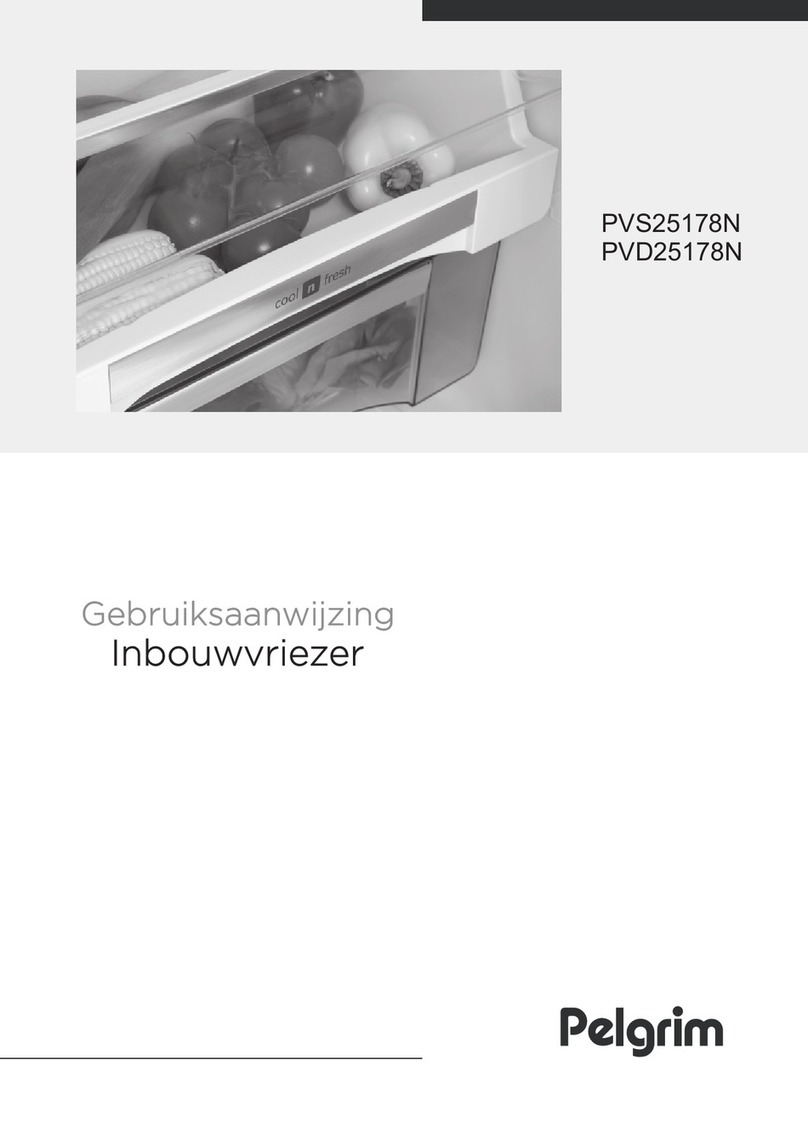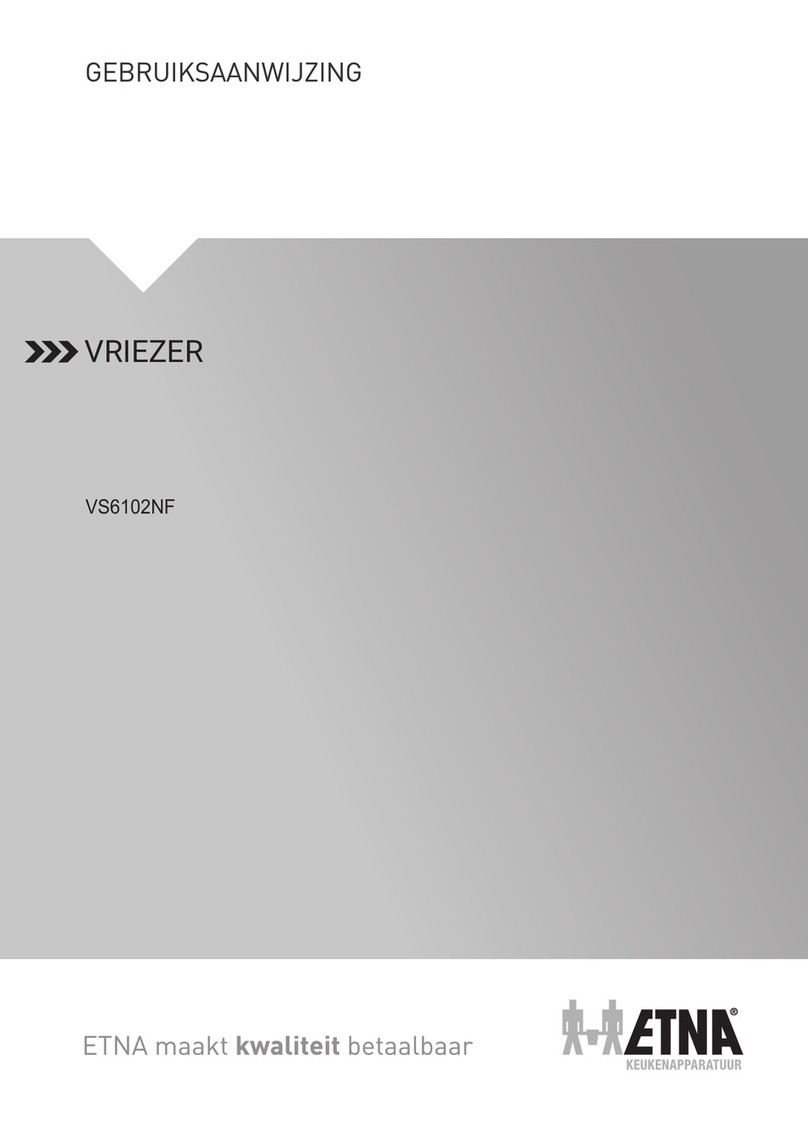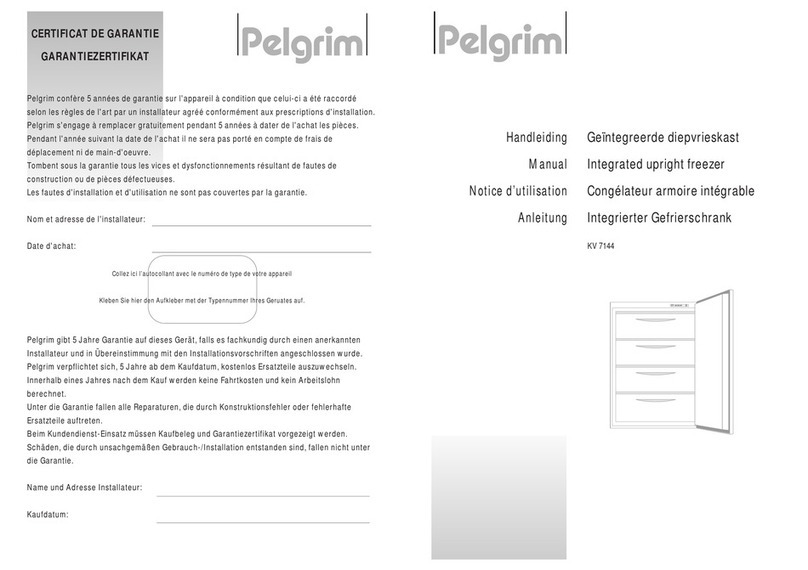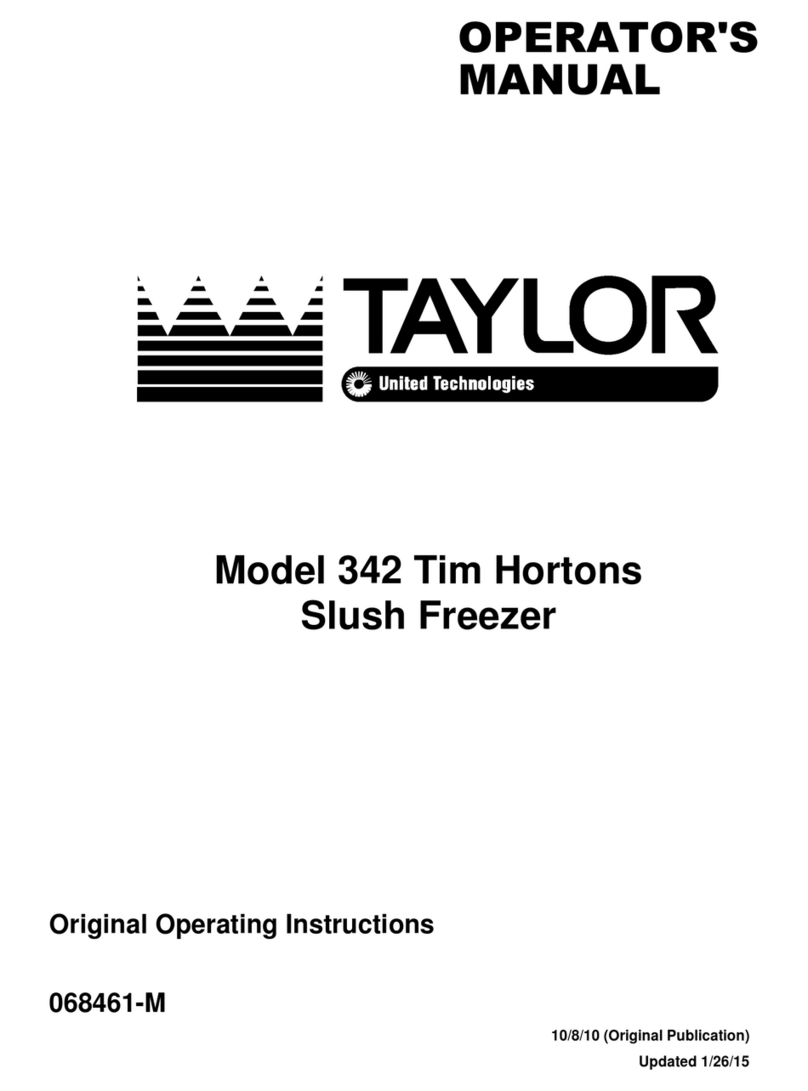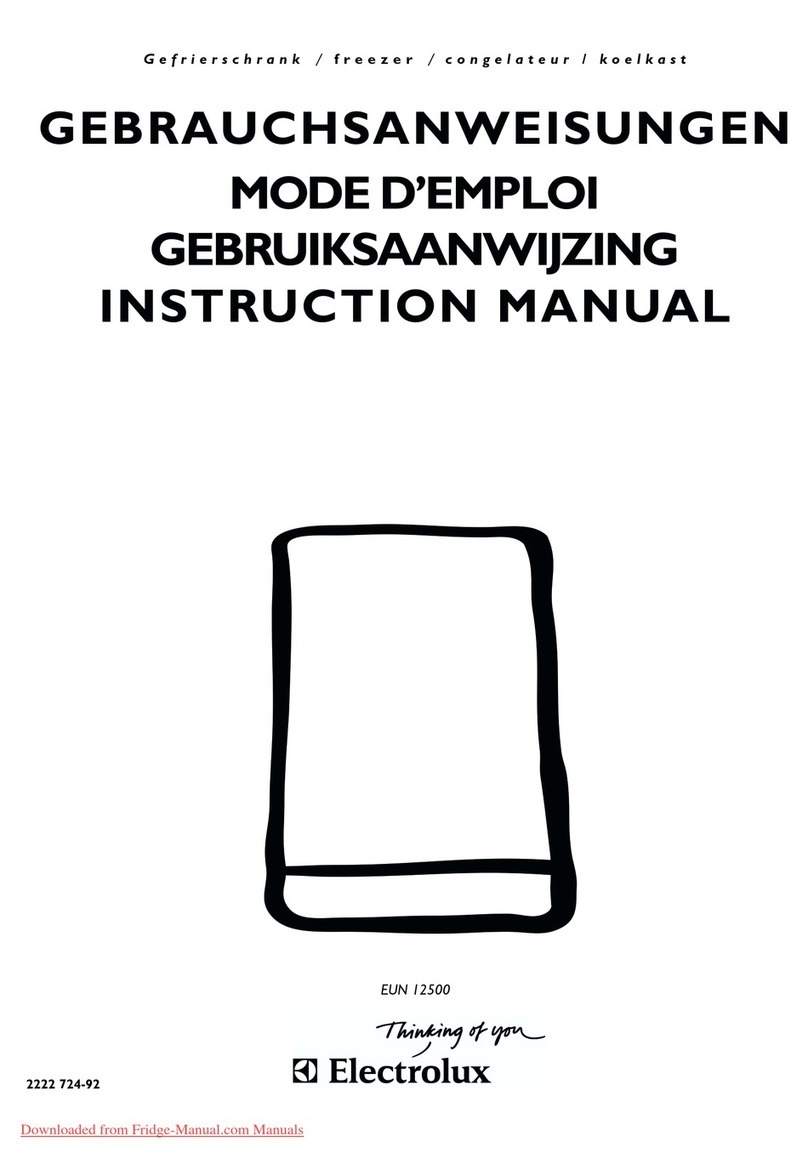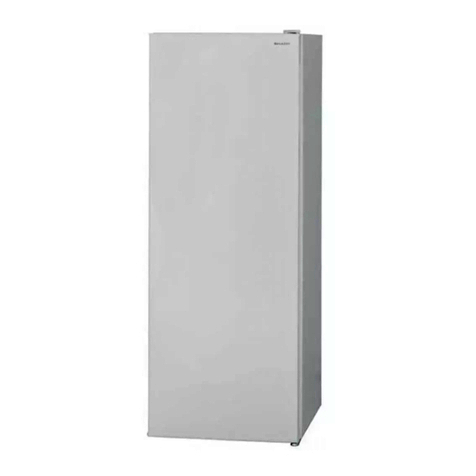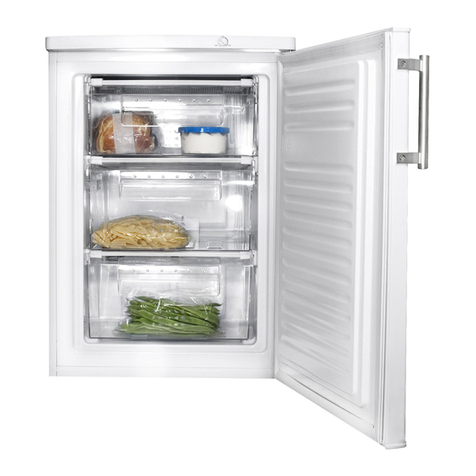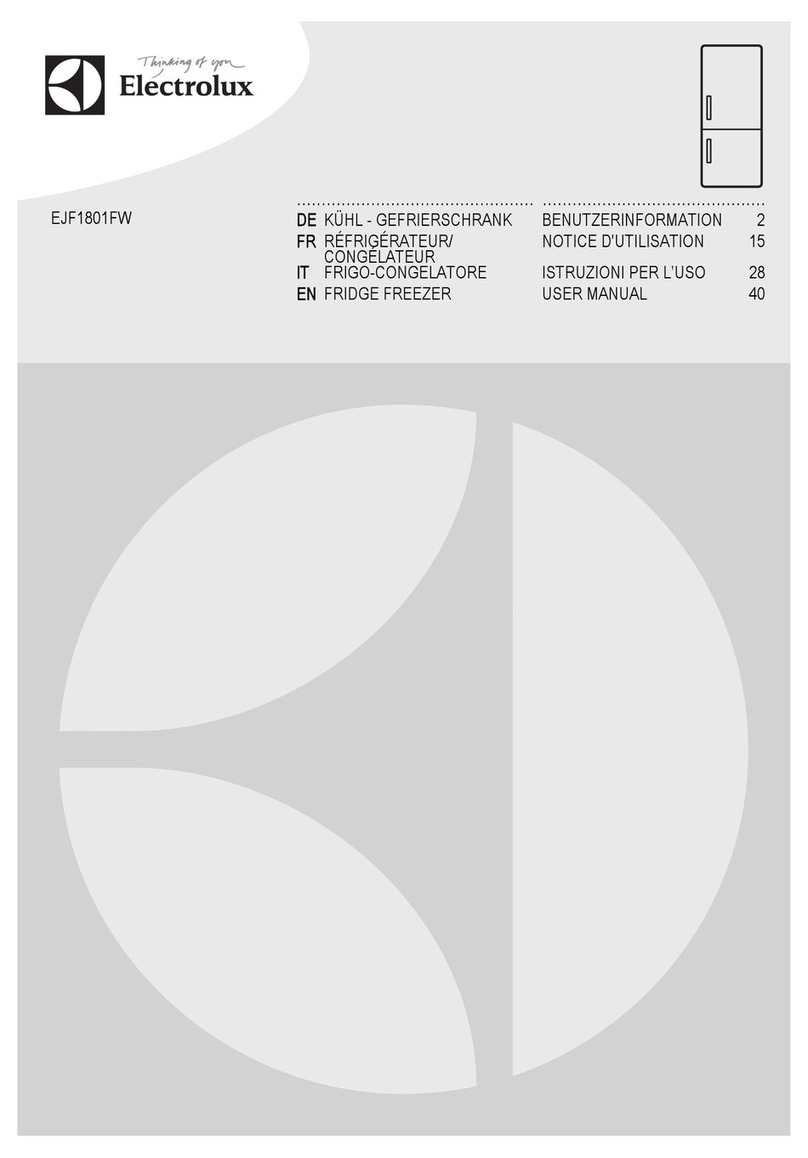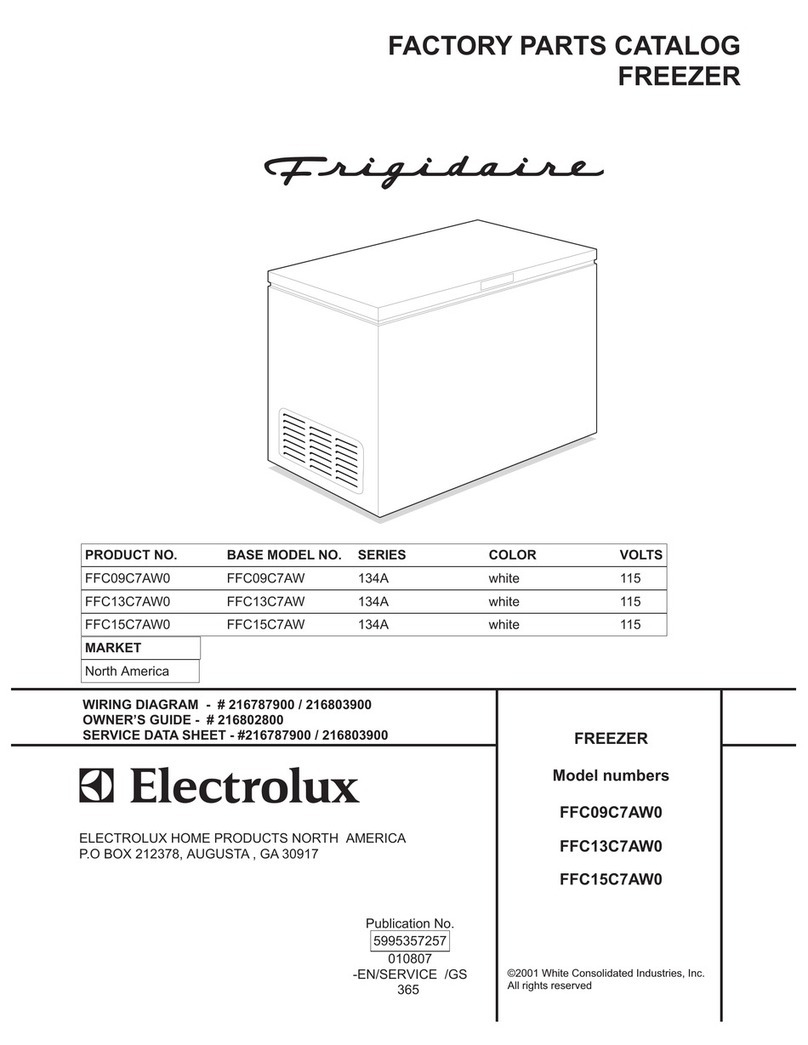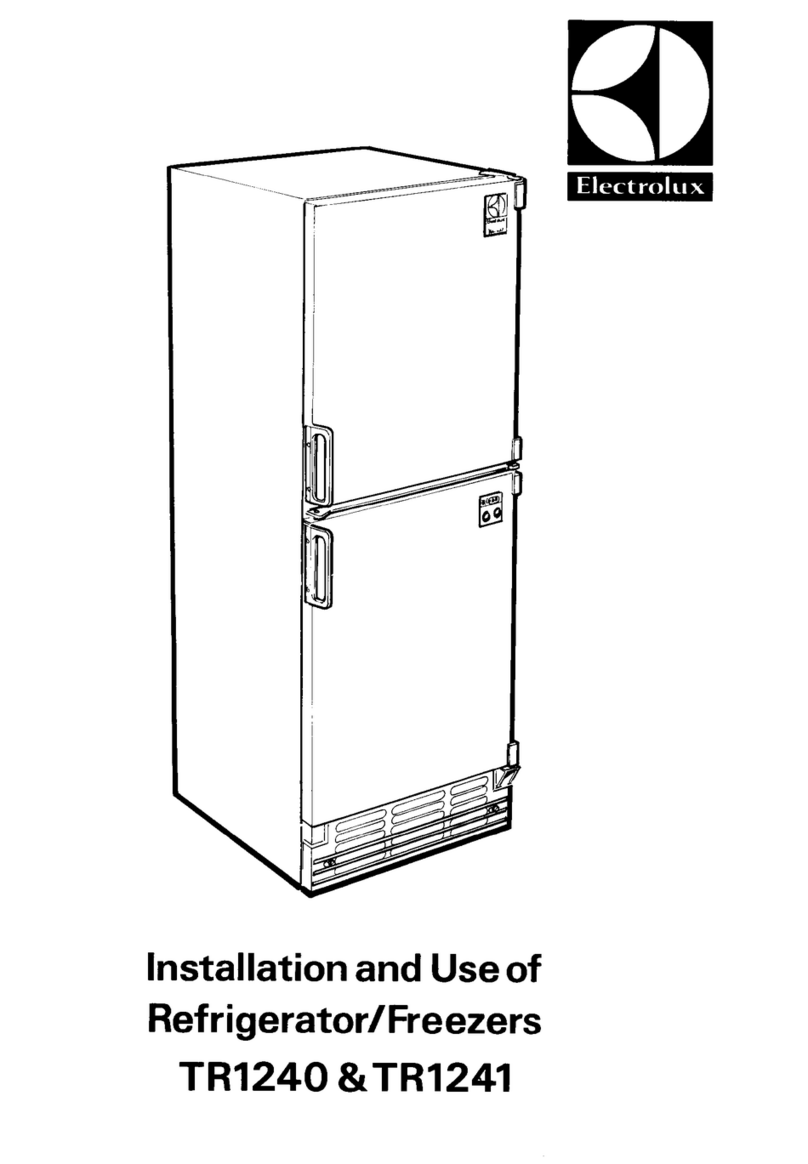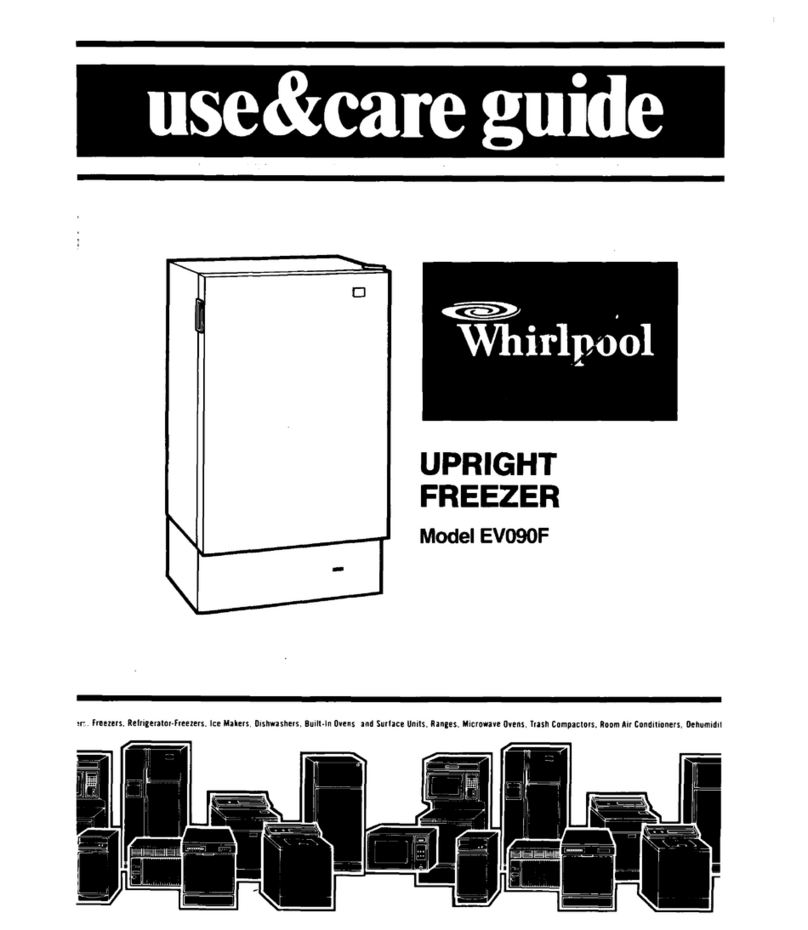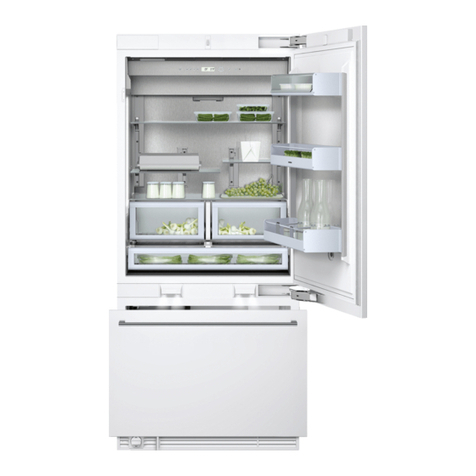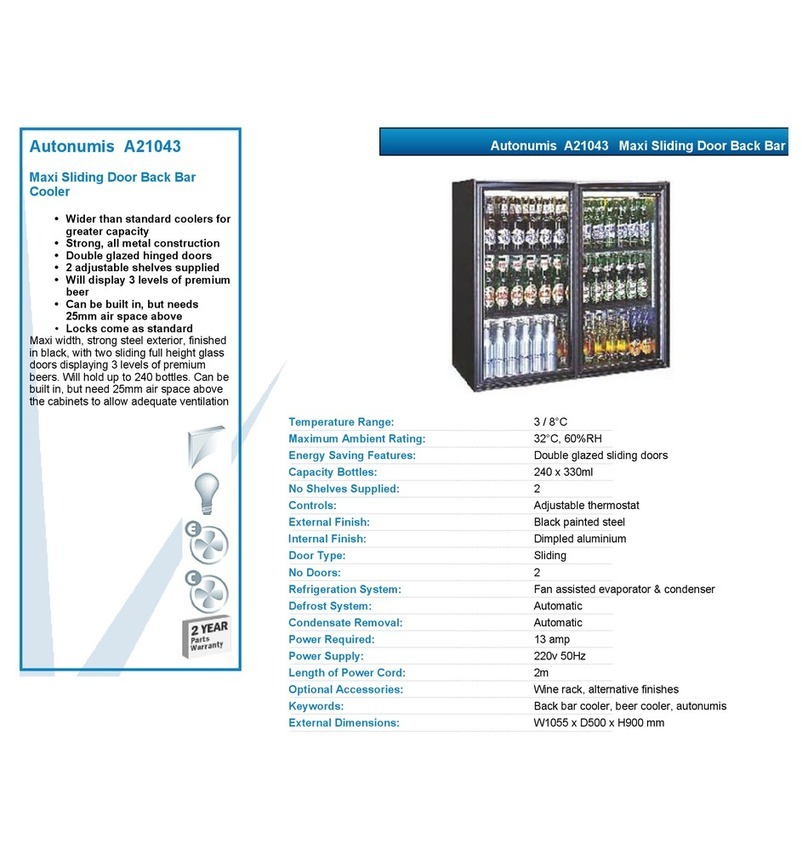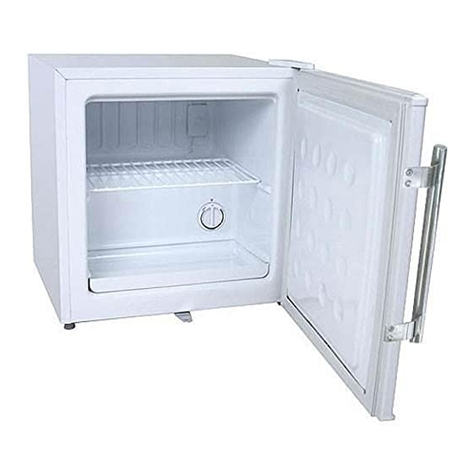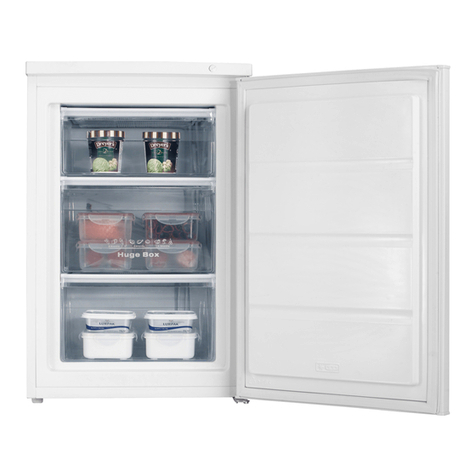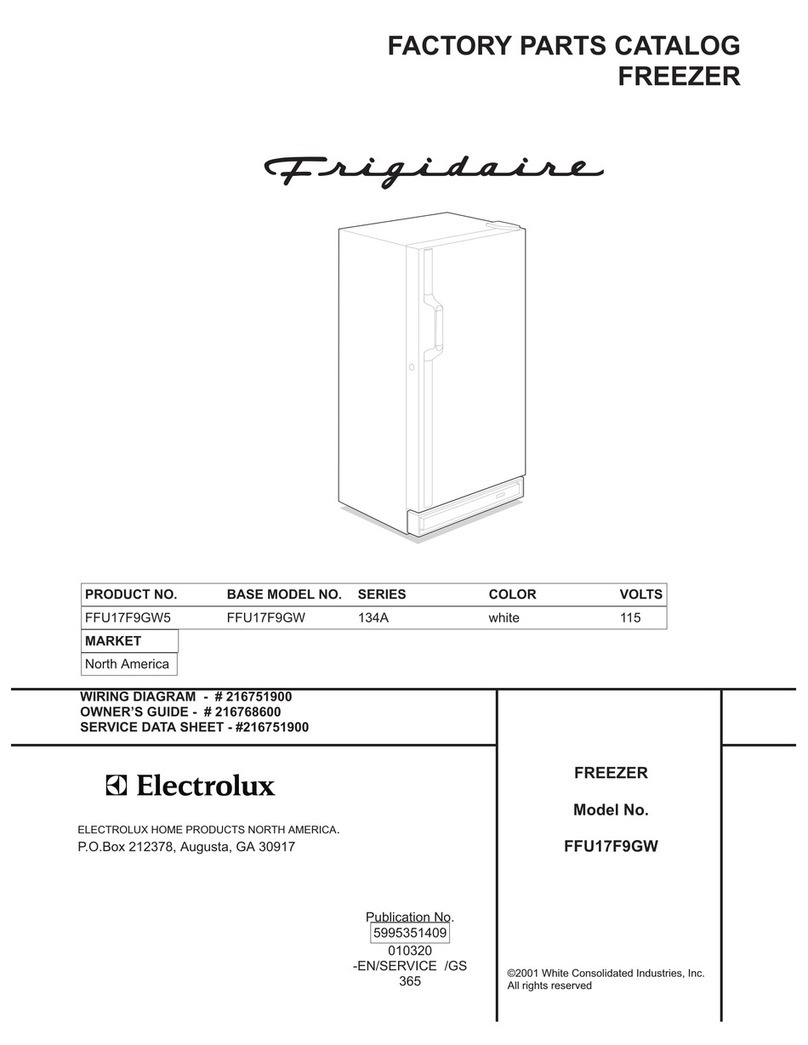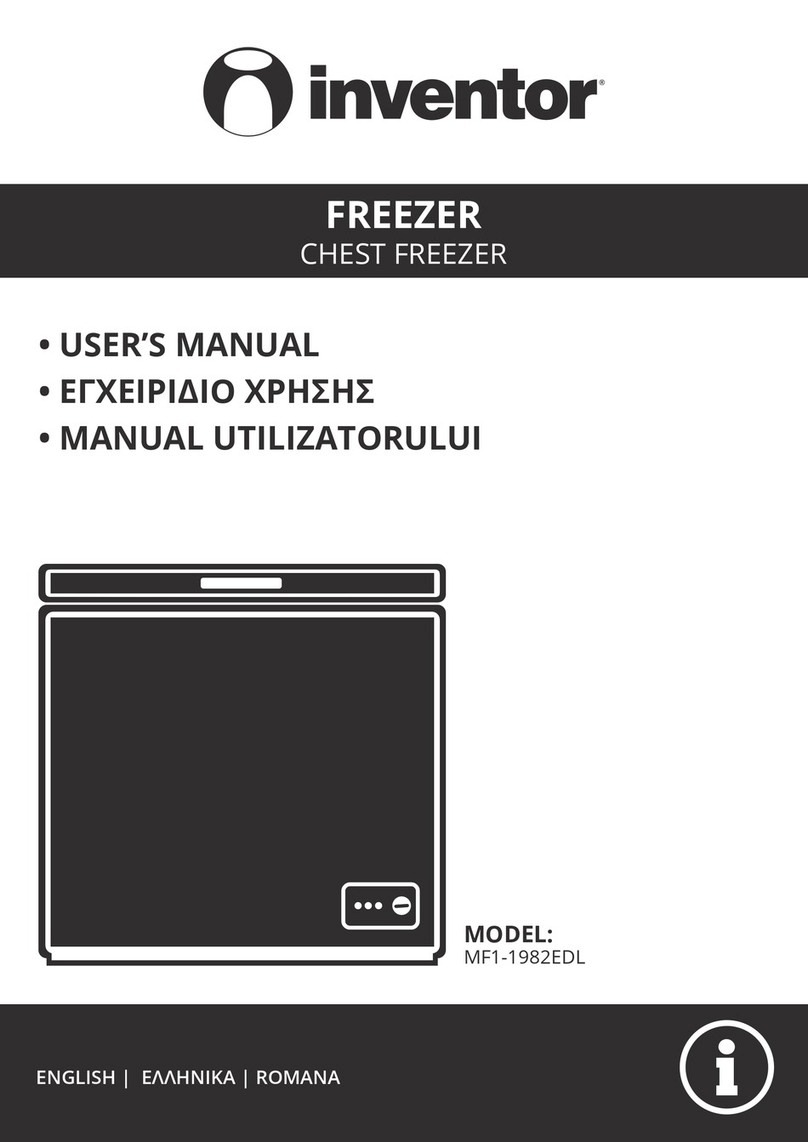Pelgrim PVS35178N User manual

Instructions for use
FREEZER
PVS25178N
PVS35178N
PVD25178N
PVD35178N

Contents
3Introduction .............................................................................................................................
3Link to the EU EPREL database ............................................................................................
4Safety instructions ..................................................................................................................
4Safety of children and vulnerable people .................................................................................
5General safety ...........................................................................................................................
6Installation .................................................................................................................................
7Electrical connection .................................................................................................................
9Use ............................................................................................................................................
10Care and cleaning .....................................................................................................................
10Disposal ....................................................................................................................................
12Installation and connection ....................................................................................................
12Selecting the location ...............................................................................................................
13Connecting the appliance .........................................................................................................
13Changing the side on which the door opens / building the appliance into a cupboard ...........
14Before using the appliance for the first time ........................................................................
14Energy-saving advice ................................................................................................................
15Description of the appliance ..................................................................................................
16Operating the appliance .........................................................................................................
16Switching the appliance on/off .................................................................................................
16Adjusting the temperature in the appliance ..............................................................................
17Intensive freezing (FastFreeze) .................................................................................................
18Open door alarm .......................................................................................................................
18High temperature alarm ............................................................................................................
19Storing and freezing food .......................................................................................................
19Recommended distribution ......................................................................................................
19Avoid contamination of food .....................................................................................................
19Freezing and storing foods in the freezer .................................................................................
21Thawing frozen food .................................................................................................................
22Maintenance ............................................................................................................................
22Defrosting the appliance ...........................................................................................................
23Cleaning the appliance .............................................................................................................
24Faults table ..............................................................................................................................
26Environmental aspects ...........................................................................................................
26Disposal of packaging and appliance .......................................................................................
2

Introduction
Congratulations on choosing this Pelgrim freezer. This product is designed with simple operation and
optimum comfort in mind.
These instructions for use explain how you can make best use of this appliance. These instructions
contain information about the operation of the appliance and background information that may be of
help to you during its use.
WARNING!
Read the safety instructions before using the appliance!
Read these instructions thoroughly before you first use the appliance, and keep the instructions
for future use.
A section of the installation instructions is supplied separately. You can find the most recent version
of the instructions for use on our website.
Link to the EU EPREL database
The QR code on the energy label supplied with the appliance provides a web link to the registration
of this appliance in the EU EPREL database. Keep the energy label for reference together with the
user manual and all other documents provided with this appliance.
It is possible to find information related to the performance of the product in the EU EPREL database
using the link https://eprel.ec.europa.eu and the model name and product number that you can find
on the rating plate of the appliance.
For more detailed information about the energy label, visit www.theenergylabel.eu.
The following symbols are used throughout the manual and they have the following meanings:
INFORMATION!
Information, advice, tip, or recommendation
WARNING!
Warning –general danger
DANGER OF FIRE!
Warning; risk of fire / flammable materials
3

Safety instructions
Before the installation and use of the appliance, carefully read
the supplied instructions. The manufacturer is not responsible
if an incorrect installation and use causes injuries and damages.
Always keep the instructions with the appliance for future
reference.
Safety of children and vulnerable people
•The appliance is not intended for use by persons (including
children) with reduced physical, sensory or mental
capabilities, or lack of experience and knowledge, unless
they have been given supervision or instruction concerning
use of the appliance by a person responsible for their safety.
•Children should be supervised to ensure that they do not
play with the appliance.
•Cleaning and user maintenance shall not be made by children
without supervision.
•Keep all packaging away from children.
For European markets only
•This appliance can be used by children aged from 8 years
and above and persons with reduced physical, sensory or
mental capabilities or lack of experience and knowledge if
they have been given supervision or instruction concerning
use of the appliance in a safe way and understand the
hazards involved.
4

•Children shall not play with the appliance.
•Cleaning and user maintenance shall not be made by children
without supervision.
•Children aged from 3 to 8 years are allowed to load and
unload refrigerating appliances.
General safety
•The lamp in this household appliance is only suitable for
illumination of this appliance. The lamp is not suitable for
household room illumination.
•WARNING! This appliance is intended to be used in
household and similar applications such as:
-staff kitchen areas in shops, offices and other working
environments;
-farm houses and by clients in hotels, motels and other
residential type environments;
-bed and breakfast type environments;
-catering and similar non-retail applications.
5

WARNING!
•Keep ventilation openings, in the appliance enclosure or
in the built-in structure, clear of obstruction.
•Do not use mechanical devices or other means to
accelerate the defrosting process, other than those
recommended by the manufacturer.
•Do not damage the refrigerant circuit.
•Do not use electrical appliances inside the food storage
compartments of the appliance, unless they are of the
type recommended by the manufacturer.
•Do not use water spray and steam to clean the appliance.
•Clean the appliance with a moist soft cloth. Only use
neutral detergents. Do not use abrasive products, abrasive
cleaning pads, solvents or metal objects.
•Do not store explosive substances such as aerosol cans
with a flammable propellant in this appliance.
•If the supply cord is damaged, it must be replaced by the
manufacturer, its service agent or similarly qualified
persons in order to avoid a hazard.
Installation
WARNING!
This appliance should only be connected by a registered
installer.
•Remove all the packaging.
6

•Do not install or use a damaged appliance.
•Obey the installation instruction supplied with the appliance.
•Always be careful when you move the appliance because it
is heavy. Always wear safety gloves.
•Make sure the air can circulate around the appliance.
•Wait at least 4 hours before connecting the appliance to the
power supply. This is to allow the oil to flow back in the
compressor.
•Do not install the appliance close to radiators or cookers,
oven or hobs.
•Do not install the appliance where there is direct sunlight.
•Do not install this appliance in areas that are too humid or
too colds, such as the construction appendices, garages or
wine cellars.
•When you move the appliance, lift it by the front edge to
avoid scratching the floor.
WARNING!
When positioning the appliance, ensure the supply cord is
not trapped or damaged.
Electrical connection
WARNING!
Risk of fire and electrical shock.
•The appliance must be earthed.
7

•All electrical connections should be made by a qualified
electrician.
•Make sure that the electrical information on the rating plate
agrees with the power supply. If not, contact an electrician.
•Always use a correctly installed shockproof socket.
•Do not use multi-plug adapters and extension cables.
•Make sure not to cause damage to the electrical components
(e.g. mains plug, mains cable, compressor). Contact the
Service or an electrician to change the electrical components.
•The mains cable must stay below the level of the mains plug.
•Connect the mains plug to the mains socket only at the end
of the installation. Make sure that there is access to the mains
plug after the installation.
•Do not pull the mains cable to disconnect the appliance.
Always pull the mains plug.
•WARNING! Do not locate multiple portable socket-outlets
or portable power supplies at the rear of the appliance.
8

•If a stationary appliance is not fitted with a supply cord and
a plug, or with other means for disconnection from the supply
mains having a contact separation in all poles that provide
full disconnection under overvoltage category III conditions,
the means for disconnection must be incorporated in the
fixed wiring in accordance with the wiring rules. This is also
applicable for appliances with a supply cord and plug when
the plug is not accessible after installing the appliance. Using
an omnipolar switch with a contact separation of at least 3
mm fitted in the fixed wiring will fulfil this requirement.
Use
WARNING!
Risk of injury, burns, electrical shock or fire.
•Do not change the specification of this appliance.
•Do not put electrical appliances (e.g. ice cream makers) in
the appliance unless they are stated applicable by the
manufacturer.
•Be careful not to cause damage to the refrigerant circuit. It
contains isobutene (R600a), a natural gas with a high level
of environmental compatibility. This gas is flammable.
•If damage occurs to the refrigerant circuit, make sure that
there are no flames and sources of ignition in the room.
Ventilate the room.
•Do not let hot items to touch the plastic parts of the
appliance.
•Do not store flammable gas and liquid in the appliance.
9

•Do not put flammable products or items that are wet with
flammable products in, near or on the appliance.
•Do not touch the compressor or the condenser. They are
hot.
Care and cleaning
WARNING!
Risk of injury or damage to the appliance.
•Before maintenance, deactivate the appliance and disconnect
the mains plug from the mains socket.
•This appliance contains hydrocarbons in the cooling unit.
Only a qualified person must do the maintenance and the
recharging of the unit.
•Regularly examine the drain of the appliance and if
necessary, clean it. If the drain is blocked, defrosted water
collects in the bottom of the appliance.
Disposal
WARNING!
Risk of injury or suffocation.
•Disconnect the appliance from the mains supply.
•Cut off the mains cable and discard it.
•Remove the door to prevent children and pets to be closed
inside of the appliance.
10

•The refrigerant circuit and the insulation materials of this
appliance are ozone friendly.
•The insulation foam contains flammable gas. Contact your
municipal authority for information on how to discard the
appliance correctly.
•Do not cause damage to the part of the cooling unit that is
near the heat exchanger.
11

Installation and connection
Selecting the location
•Place the appliance in a dry and well aired room. The permitted
ambient temperature range for the appliance depends on the
appliance's climate class, which is shown on the type plate.
•Do not place the appliance near a source of heat, such as a gas cooker, radiator or boiler, etc.,
and do not expose it to direct sunlight.
Relative humidityAmbient temperature range °CClassDescription
≤75%
+10 to +32SNExtended temperate
+16 to +32NTemperate
+16 to +38STSubtropical
+16 to +43TTropical
WARNING!
Do not place the appliance in a room where the temperature can fall below the lowest permitted
ambient temperature: the appliance may not work properly!
WARNING!
Do not place the appliance in a room where the temperature can fall below 5 °C: the appliance
may not work properly or become defective!
WARNING!
The appliance is not suitable for outdoor use and it may not be exposed to rain.
•The appliance must be placed at a distance of at least 5 cm from an electrical or gas cooker and
at least 30 cm from a radiator or heater. An insulation panel must be fitted when these distances
cannot be kept.
•The appliance must be placed at a distance of about 5 cm from the wall, back and sides of a
cupboard. A kitchen cupboard above the refrigerator must have a gap of at least 5 cm between
the back of the cupboard and the wall. This is needed to make sure that there is sufficient cooling
air for the condenser.
•The plug of the installed appliance must remain accessible!
WARNING!
Place the appliance in a room with a sufficient volume of air. The room must have a volume of
at least 1 m3of air for every 8 grams of refrigerant. The quantity of refrigerant is shown on the
type plate on the inside of the appliance.
12

•The kitchen unit in which the appliance is to be built in must have an opening of at least 200 cm2
in its base to allow sufficient air to circulate.
•The appliance's air outlet is at the top. Make sure that the outlet is not blocked. Blocking the outlet
can result in damage to the appliance.
WARNING!
An anti-condensation accessory must be installed before built-in appliances are installed next
to each other in a cupboard or surround. For safety reasons, this must be installed by a
recognized installer!
Connecting the appliance
•Connect the appliance to the power supply with a plug. The socket must be earthed. The nominal
voltage and frequency required for the appliance are shown on the appliance's type plate/label
with basic information.
•The appliance must be connected to the mains and earthed in accordance with the prevailing
standards and regulations. The appliance can withstand small variations in the mains voltage to
a maximum of plus or minus 6%.
WARNING!
When you are not going to use the appliance for a longer period then switch it off with the
appropriate key and disconnect it from the mains. Empty, defrost and clean the appliance, and
leave the door ajar.
WARNING!
Freeze burn hazard
To avoid freeze burn, never put frozen food in your mouth and do not touch frozen food.
WARNING!
In the event of a defect or power cut, do not open the freezer compartment unless the appliance
has been out of operation for more than the hours indicated on the appliance’s type plate
(temperature rise time). After this time, you must either use the frozen food or make sure that it
is properly cooled (for example, by transferring it to another appliance).
Changing the side on which the door opens / building the
appliance into a cupboard
Information about changing the side on which the door opens and building the appliance into a
cupboard is enclosed in separate installation instructions.
13

Before using the appliance for the first time
Do not connect the appliance to the mains until you have carefully read the instructions for the correct
and safe use of the appliance. As these instructions are for various types and models, it is possible
that the instructions for use refer to settings or parts that are not available on your appliance. We
recommend that you keep these instructions for future use. If you sell the appliance, enclose them
with the appliance.
Inspect the appliance for damage and/or irregularities. If the appliance is damaged, contact the store
that sold you the appliance.
Allow the appliance to stand upright for at least 4 hours before you connect the appliance to the mains.
This reduces the risk of malfunctions resulting from transport effects on the refrigerant unit.
Before using the appliance for the first time, the interior and all internal accessories should be cleaned
with lukewarm water and a neutral cleaning agent. Wipe the cleaned parts with a cloth with clean
water and then dry them thoroughly.
If you use the appliance for the first time, do not put food into the appliance until the temperature has
decreased to the set temperature.
Energy-saving advice
•Install the appliance as stated in the instructions for use.
•Do not open the door more than necessary.
•Never cover or obstruct the ventilation openings.
•Replace a door seal that is damaged or no longer seals properly as quickly as possible.
•Store food in well-sealed containers or suitable packaging.
•Allow food to cool to room temperature before you put it in the appliance.
•The lower the set temperature, the higher the power consumption.
14

Description of the appliance
1. Control panel
2. LED lighting
3. NoFrost freezer unit
4. Freezer compartment
5. Freezer drawers
Best location for freezing fresh food.
NoFrost
With the NoFrost system, you no longer need to defrost the freezer.
LED interior lighting
The appliance has LED lighting at various locations.
This product contains a light source of energy efficiency class <E>.
Ice cube tray
To make ice cubes, fill the tray with water and lay it horizontally in the
freezer.
15

Operating the appliance
Appliance on/off, temperature settings, and extra function keyA
Temperature displayB
The indicator for the selected temperature will be lit.
Intensive freezing function indicatorC
Symbol Cwill be lit when the intensive freezing function is activated.
High temperature indicatorD
To set the appliance temperature or activate extra functions, press the Akey successively. When the
key is first pressed, the currently set value or function will start to flash. With each successive press
of the key, the indicator moves to the next setting. The indicator cycles through the settings in a circular
manner, from right to left. While the settings are being adjusted, the display will flash. Three seconds
after the key is released, the setting will be stored automatically and the relevant symbol will be lit.
Switching the appliance on/off
Switching the appliance on: Press the Akey and hold it for 3 seconds.
Switching off the appliance: Again press the Akey and hold it for 3
seconds. The appliance will be off, but there is still voltage in it as it is
still connected to the power mains.
Adjusting the temperature in the appliance
INFORMATION!
•The factory default setting is the recommended temperature of -18 °C.
WARNING!
After you have switched on the appliance it will take several hours for the temperature to decrease
to the set temperature. Do not put food into the appliance until the temperature has decreased
to the set temperature.
16

•Adjust the temperature as desired using the Akey.
•Press the Akey (several times) until the desired temperature indicator
lights up.
•When the Akey is pressed for the first time, the currently set value
or function will start to flash. Every successive time you press the A
key, the settings indicator will move to the next setting (from right to
left, in a circular manner).
•After three seconds, the setting will stop flashing. Your setting will
be stored and the corresponding indicator will be continuously lit.
The numbers -24, -22, -20, -18 and -16 indicate the degrees Celsius (°C)
in the appliance.
•The recommended temperature setting is -18 °C. At this temperature,
food quality and freshness are preserved longer.
•If the ambient temperature in the room where the appliance is
installed is below 16 °C, we recommend setting a temperature lower
than -18 °C.
Intensive freezing (FastFreeze)
This appliance has an intensive freezing function. This function decreases the temperature in the
freezer compartment as quickly as possible. Activate this function 24 hours before you put a large
quantity of fresh food in the appliance.
INFORMATION!
When the intensive freezing function is selected, the appliance works at maximum capacity. It
may then make more noise for a while.
•To activate the intensive freezing function, press the Akey several
times until symbol Clights up.
•To switch off the intensive freezing function, press the Akey to select
the desired temperature B.
INFORMATION!
Adjusting the temperature of the freezer compartment while the intensive freezing function is
activated will immediately disable the intensive freezing function.
INFORMATION!
When the intensive freezing function is not manually disabled then the function will be automatically
disabled after about two days. The temperature then returns to the latest set temperature.
INFORMATION!
Should a power failure occur while the function is activated then the function will be activated
again when the power is restored.
17

Open door alarm
An alarm signal sounds when the door is open for too long.
Switching off the alarm:
1. Close the door.
•The alarm will stop sounding.
INFORMATION!
If you only switch off the alarm by touching the Akey, the alarm will switch on again after some
time because the door is still open.
High temperature alarm
A signal will sound when the temperature in the appliance is too high. Furthermore, symbol Dshown
in the display will flash. A high temperature can be caused for several reasons:
•The door has been opened for too long or too frequently.
•The door does not seal properly.
•Too much fresh food has been put in at the same time.
WARNING!
Every time the appliance is switched on again, it takes a while until the correct temperature is
reached. For this reason, the alarm is disabled for the first 24 hours after the appliance is switched
on to prevent the unnecessary activation of the alarm.
Switching off the alarm:
1. Touch the Akey to stop the alarm.
•The alarm will stop sounding.
•Symbol Dshown in the display continues to flash while the
temperature is still too high.
INFORMATION!
When you press the Akey for the first time, the alarm will be acknowledged and turned off. When
you press the Akey again, it will already work as a settings adjustment key.
WARNING!
When the alarm is not stopped manually and the temperature remains too high, the signal will
sound for the first minutes of every half hour and when the door of the refrigerator compartment
is opened.
18

Storing and freezing food
Recommended distribution
Sections of the refrigeration compartment
The best location for freezing fresh food is marked with a .
WARNING!
Do not store lettuce, eggs, apples, pears, grapes, peaches, yoghurt, buttermilk, sour cream or
mayonnaise in the freezer.
Avoid contamination of food
To avoid contamination of food, please respect the following instructions:
•Opening the door for long periods can cause a significant increase of the temperature in the
compartments of the appliance.
•If the refrigerating appliance is left empty for long periods, switch off, defrost, clean, dry, and leave
the door open to prevent mould developing within the appliance.
Freezing and storing foods in the freezer
Important recommendations for freezing fresh food
•The maximum quantity of food that you can put in the freezer in one go is stated on the type plate.
Putting more than this maximum quantity of food into the freezer will slow the freezing process
and reduce the quality. Moreover, this will also harm the quality of frozen food already stored in
the freezer.
•Use only good-quality fresh food that is suitable for freezing.
•Allow hot food to cool to room temperature.
19

•Food needs to be frozen quickly. It is recommended that you use small packs.
•Use air and watertight packaging to prevent the food from drying out and lose its vitamins.
•Note the type and quantity of the food on the packaging, together with the date on which it was
frozen.
•Do not allow fresh food to come into contact with frozen food.
•You can remove all the drawers to make use of the total volume of the freezer compartment.
•Put the food directly on a shelf and on the base of the freezer.
Freezing small quantities of fresh food/making ice cubes
See the chapter ‘Recommended distribution’for the best location for freezing fresh food (1 to 2
kilograms) and making ice cubes.
Freezing large quantities of fresh food
•Activate the intensive freezing function 24 hours before you plan to freeze the food.
•Distribute the fresh food equally between all the drawers in the freezer compartment.
•After 24 hours, you can transfer the food to another compartment in the freezer and then freeze
a new batch of food.
Important recommendations for storing frozen food
•Follow the manufacturer’s instructions for the storage and use of frozen food. Take note of the
recommended storage temperature and use-by date stated on the packaging.
•Use only food in undamaged packaging that has been stored at a temperature of -18 °C or lower.
•Do not buy food covered in frost. This indicates that the food has thawed or partially thawed
several times and, as a result, is of inferior quality.
•Make sure that the food does not thaw during transport. An increase in its temperature will shorten
the storage life and harm the quality of the food.
Recommended storage times of frozen food in the freezer
Storage lifeType of food
10 to 12 monthsFruit, beef
8 to 10 monthsVegetables, veal, poultry
6 to 8 monthsVenison
4 to 6 monthsPork
4 monthsFinely chopped or minced meat
3 monthsBread, pastas, cooked dishes, whitefish
2 monthsOffal
1 monthSmoked sausage, bluefish
20
This manual suits for next models
3
Table of contents
Other Pelgrim Freezer manuals
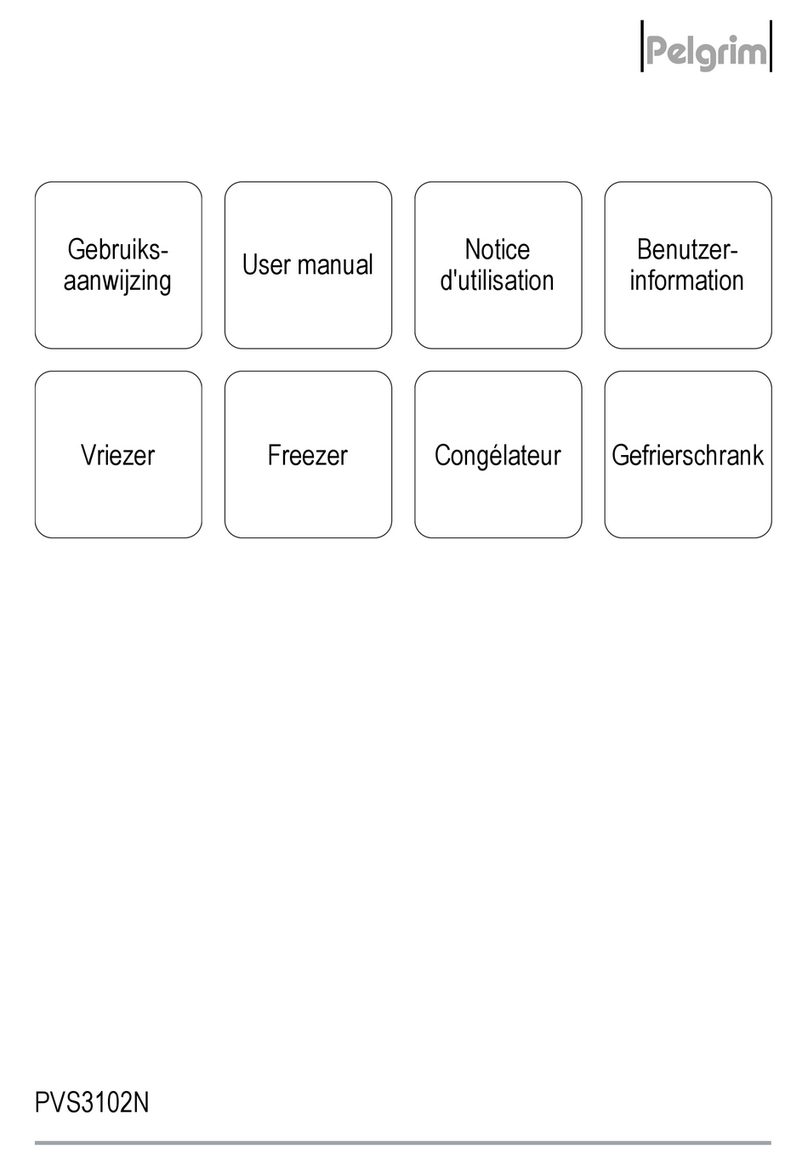
Pelgrim
Pelgrim PVS3102N User manual

Pelgrim
Pelgrim ZOPI1066 User manual
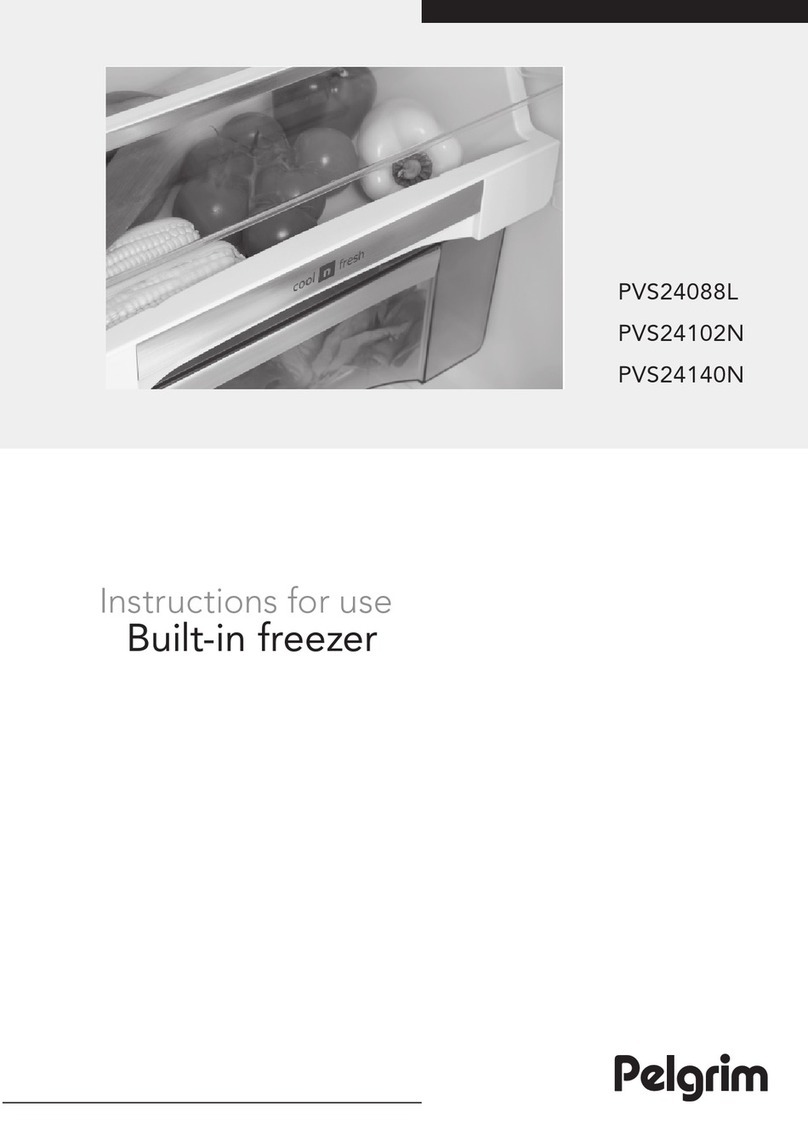
Pelgrim
Pelgrim PVS24102N User manual
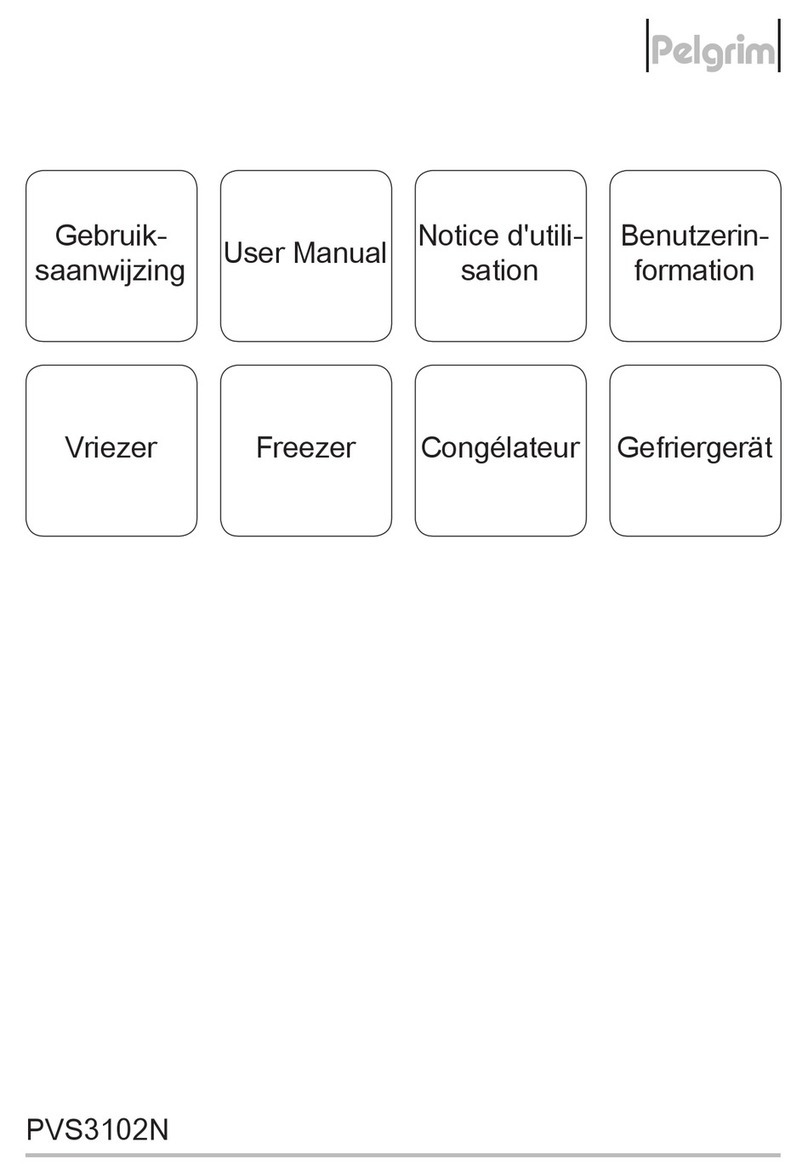
Pelgrim
Pelgrim PVS3102N User manual

Pelgrim
Pelgrim OVG 214 User manual
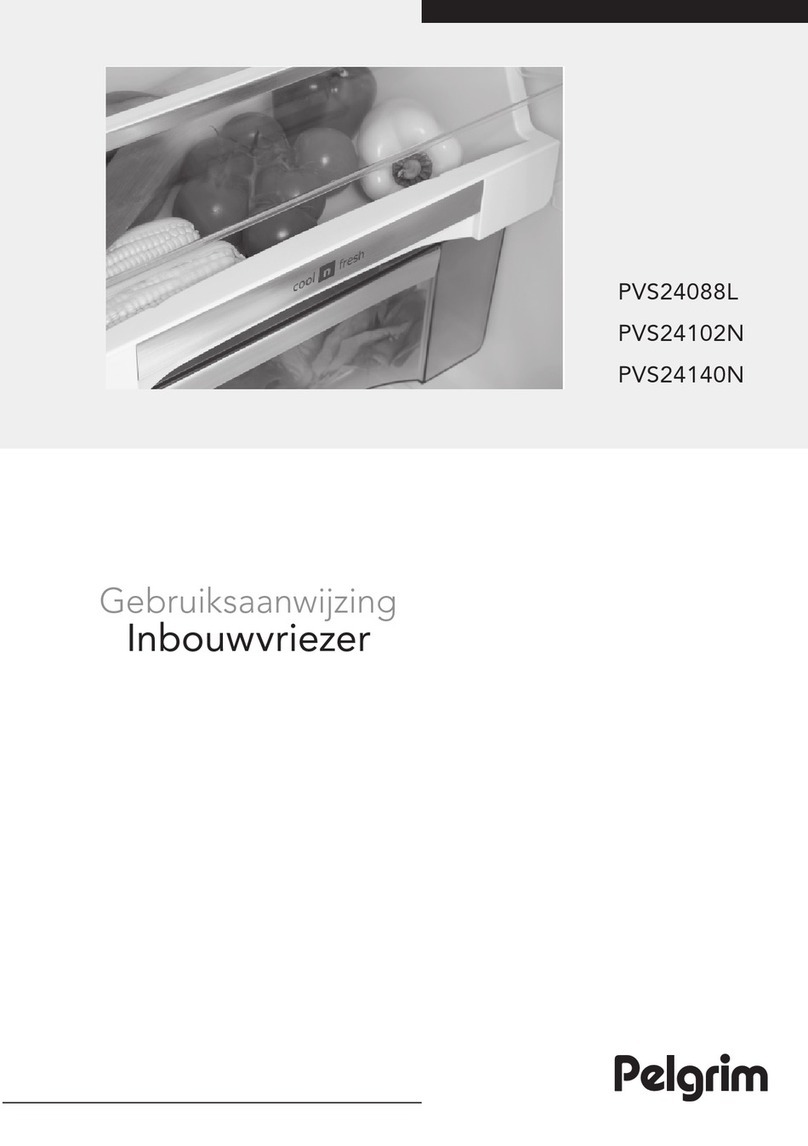
Pelgrim
Pelgrim PVS24088L User manual
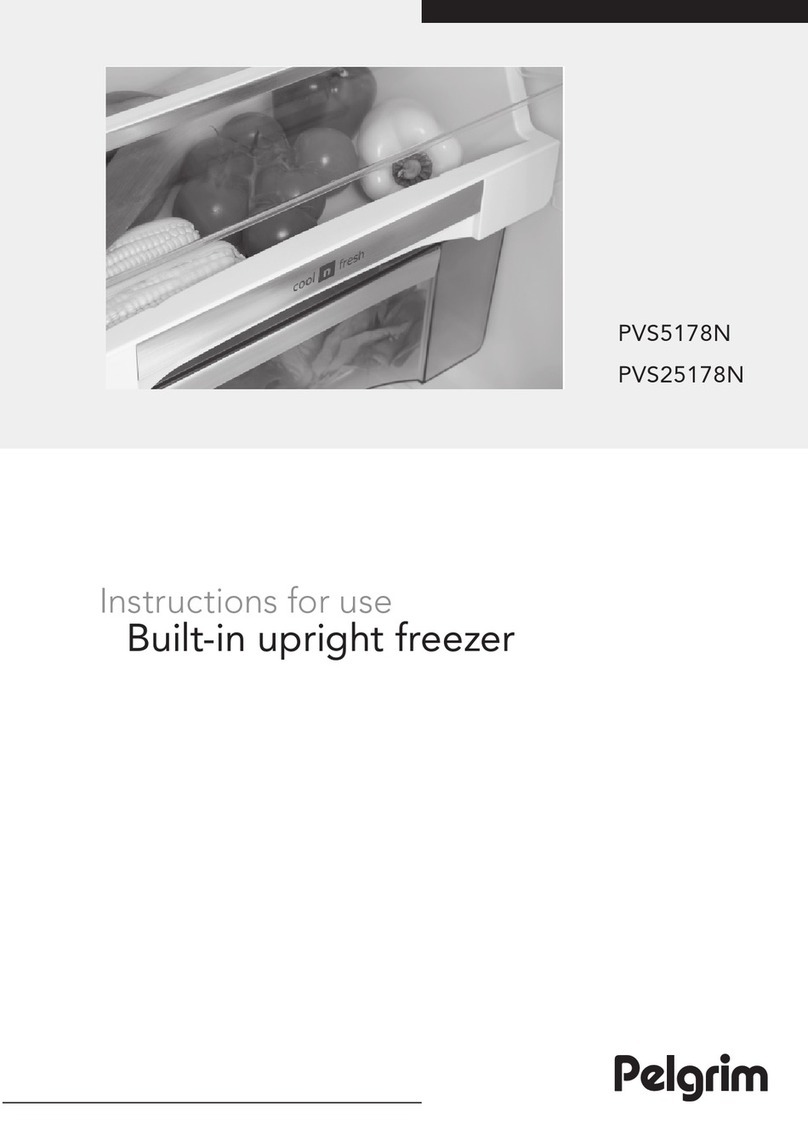
Pelgrim
Pelgrim PVS5178N User manual
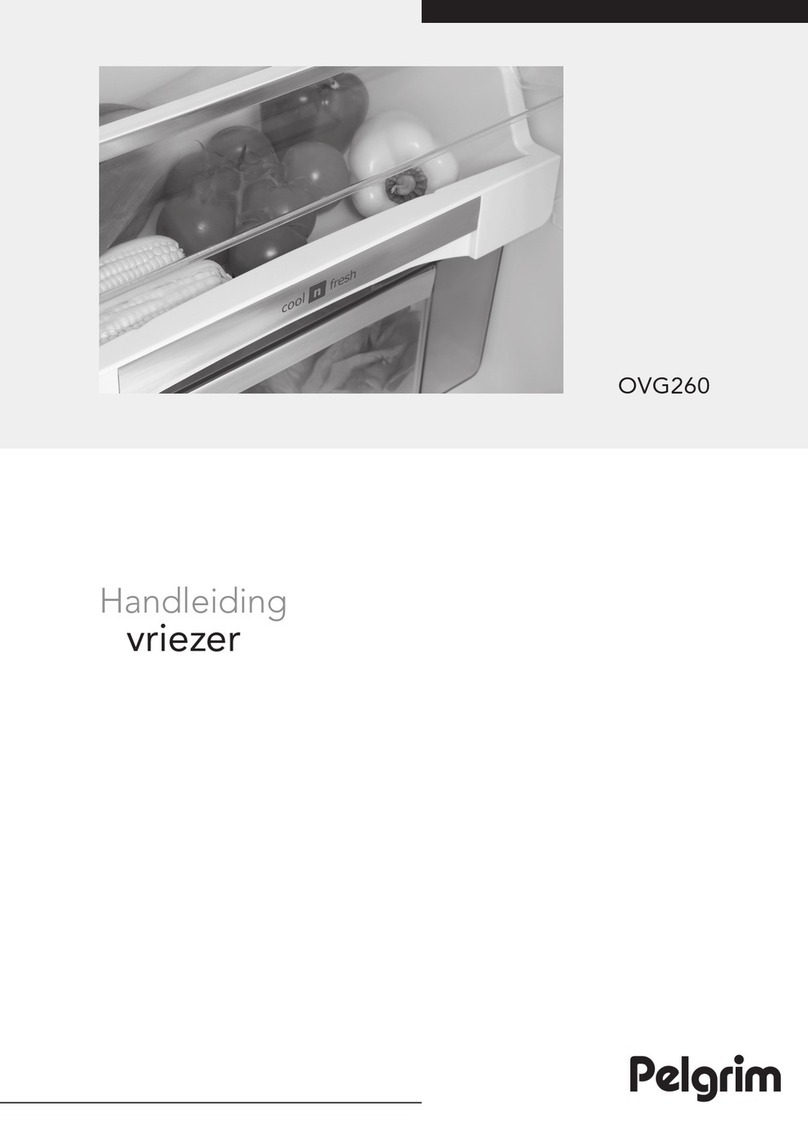
Pelgrim
Pelgrim OVG260 User manual

Pelgrim
Pelgrim PVO3082 User manual
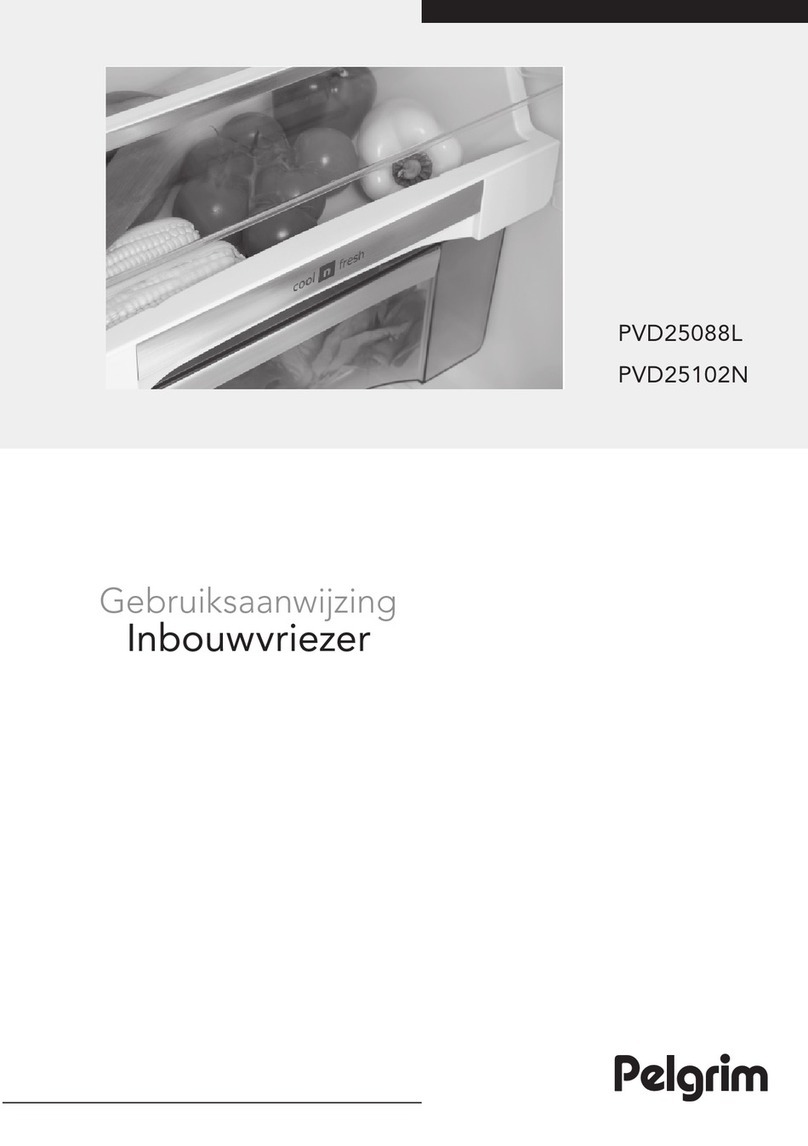
Pelgrim
Pelgrim PVD25102N User manual


